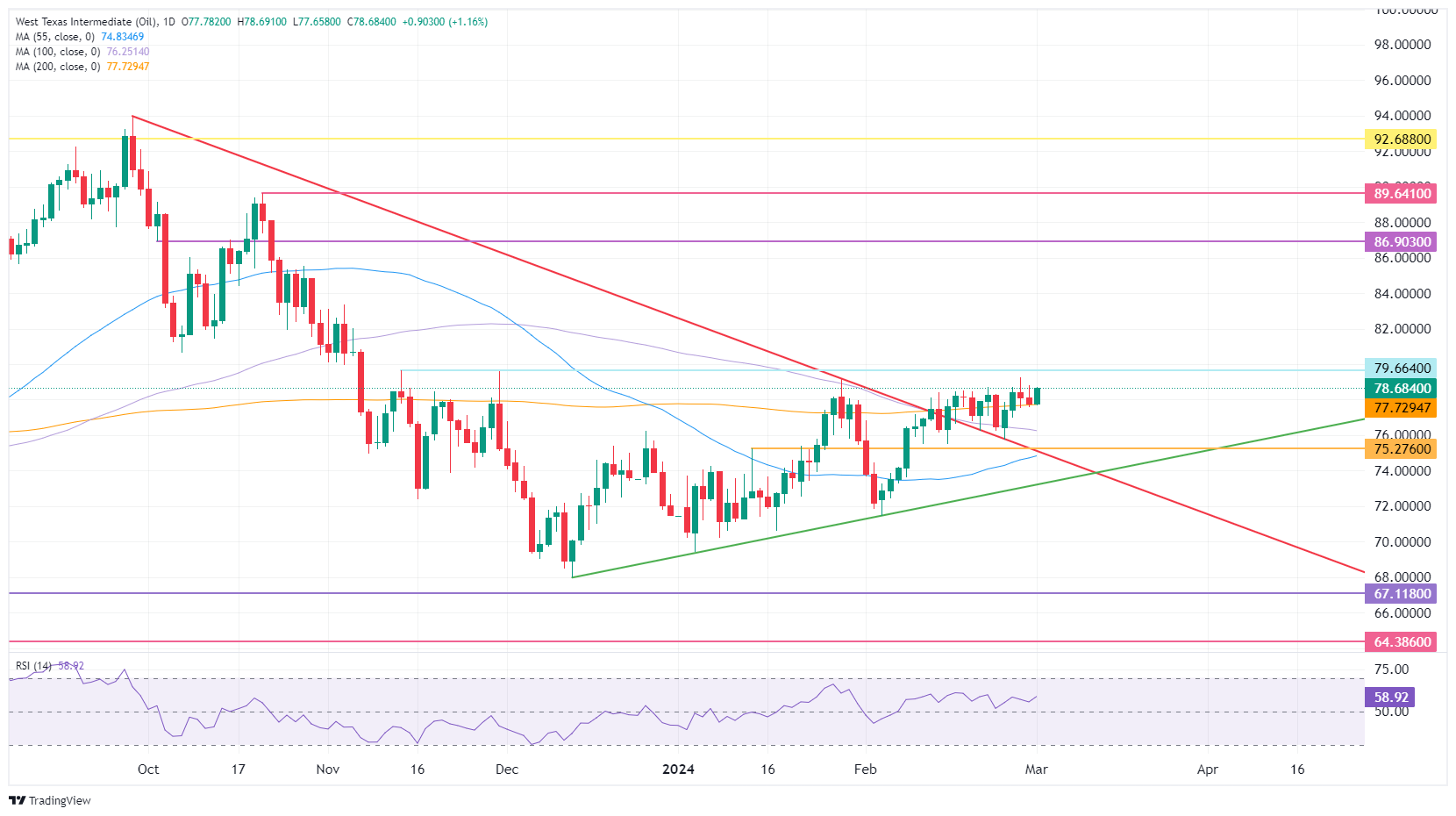- WTI oil reaches $79 due to Friday's strong rise.
- Oil traders see bullish signs as US macroeconomic data points to a recovery and OPEC looks set to prolong its production cuts.
- The Dollar Index has returned to above 104.00, although it fails to clearly break a fundamental level.
Oil prices rose on Friday and are trading near $79 ahead of the US markets open this Friday, in what has already been a profitable week for oil. Markets are attentive to confirmation that OPEC will extend its current production cuts until the second quarter of the year. Although these production cuts are voluntary, they are a key factor in helping to maintain oil prices at current levels.
Meanwhile, the US Dollar Index (DXY) is trading in a very tight range despite the release of important economic data and an army of US Federal Reserve speakers making comments to the markets. throughout the week. Tensions are building in markets: As Fed officials talk about the timing of an interest rate cut or the number of upcoming cuts, the latest inflation data points to the possibility of a rate hike to counter the possible secondary effects on inflation.
Crude oil (WTI) is trading at $79.27 per barrel, and Brent is trading at $83.14 per barrel at the time of writing.
Oil news and market movements: Refiners buy
- Middle East oil refiners have bought large quantities of crude oil from Oman and Kuwait that was normally destined abroad.
- This week's US stockpile data reveals that the US is replenishing at a ferocious pace. Data from the American Petroleum Institute and the Energy Information Administration pointed to a considerable buildup of inventories.
- At 18:00 GMT the weekly Baker Hughes oil rig count will be published. The previous reading stood at 503.
- OPEC has no choice but to prolong current production cuts if it does not want to trigger a substantial drop in crude oil prices.
- A significant portion of Libya's oil supply has returned to operation after protests at one of its major oil fields ended.
Oil prices draw support from the fact that traders expect OPEC to do whatever is necessary to maintain current price levels. This, of course, is a bit risky, since the current production cuts among OPEC countries are voluntary, and can only be confirmed after actual export figures are published…. Should OPEC really want to matter, it might be necessary not only to prolong, but to further deepen these production cuts.
Oil bulls are focused on the double top near $79.66, ahead of $80.00. Once this area is overcome, a large space opens towards $86.90, which would mean an increase of almost 10%. Just before $90, $89.64 could stand in the way of $100.00.
To the downside, the 200-day SMA near $77.72 is the first contact point that offers some support. Next, the 100-day and 55-day SMAs, near $76.25 and $74.83 respectively. If we add to this the $75.27 level, it seems that the downtrend is very limited and well prepared to resist the selling pressure….

US WTI Crude Oil: Daily Chart
WTI Oil FAQ
What is WTI oil?
WTI oil is a type of crude oil that is sold in international markets. WTI stands for West Texas Intermediate, one of the three main types that include Brent and Dubai crude. WTI is also known as “light” and “sweet” for its relatively low gravity and sulfur content, respectively. It is considered a high-quality oil that is easily refined. It is sourced in the United States and distributed through the Cushing facility, considered “the pipeline junction of the world.” It is a benchmark for the oil market and the price of WTI is frequently quoted in the media.
What factors determine the price of WTI oil?
Like all assets, supply and demand are the main factors that determine the price of WTI oil. As such, global growth can be a driver of increased demand and vice versa in the case of weak global growth. Political instability, wars and sanctions can alter supply and impact prices. The decisions of OPEC, a group of large oil-producing countries, is another key price factor. The value of the US Dollar influences the price of WTI crude oil, as oil is primarily traded in US dollars, so a weaker Dollar can make oil more affordable and vice versa.
How do inventories influence the price of WTI oil?
Weekly oil inventory reports published by the American Petroleum Institute (API) and the Energy Information Agency (EIA) influence the price of WTI oil. Changes in inventories reflect the fluctuation of supply and demand. If the data shows a decline in inventories, it may indicate an increase in demand, which would drive up the price of oil. An increase in inventories can reflect an increase in supply, which drives down prices. The API report is published every Tuesday and the EIA report the next day. Their results are usually similar, with a difference of 1% between them 75% of the time. EIA data is considered more reliable since it is a government agency.
How does OPEC influence the price of WTI oil?
OPEC (Organization of the Petroleum Exporting Countries) is a group of 13 oil-producing nations that collectively decide member countries' production quotas at biannual meetings. Their decisions often influence WTI oil prices. When OPEC decides to reduce quotas, it can restrict supply and drive up oil prices. When OPEC increases production, the opposite effect occurs. OPEC+ is an expanded group that includes ten other non-OPEC member countries, including Russia.
Source: Fx Street
I am Joshua Winder, a senior-level journalist and editor at World Stock Market. I specialize in covering news related to the stock market and economic trends. With more than 8 years of experience in this field, I have become an expert in financial reporting.







